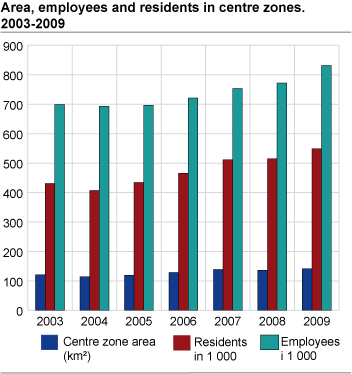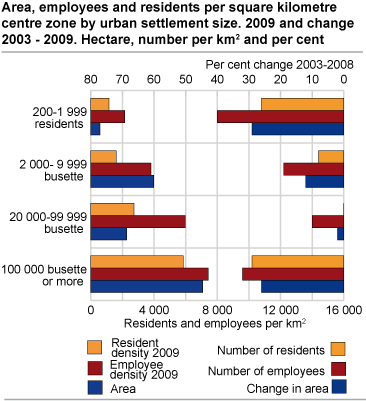Content
Published:
This is an archived release.
Centre zone growth and density increase
Last year the number of residents, as well as employees and centre zone areas increased. The increase in the number of residents and employees surpassed the increase in area, leading to a density increase in the centre zones.
People are increasingly choosing to live in urban areas. It is also a political goal to utilise the urban area as intensely as possible in order to ease the pressure on the surrounding land and at the same time minimise the need for transport.
Slightly more than 550 000 people (almost 11 per cent of the population) lived in centre zones in Norway as of 1 January 2009. The centre zones have increased continuously during recent years. From 2003 to 2009, the number of residents rose by 27 per cent, while the urban settlement population increased by 8 per cent in the same period.
The number of employees also increased in the period but not as much as the growth in the number of residents. The area of centre zones has increased but not as much as the number of residents and employees, thus leading to a density increase.
High density of residents is an indicator for effective land use utilisation as well as less energy-intensive transportation. High density of residents can on the other hand indicate poor dwelling conditions, scarcity and pressure on green areas.
The density in centre zones increases by urban settlement size. There are more employees than residents per square kilometre in all size groups. In the biggest cities there are almost 4 times as many employees and 6 times as many residents per km2 compared to small urban settlements. The centre zone growth has been equally high in big cities and smaller urban settlements alike. The resident density has had weakest growth in the big cities and employee density has even had a slight decrease.
The different size groups do not necessarily include the same urban settlements. Urban settlement growth can lead to a shift towards the upper size groups and small settlements on the other hand can fall under the definition criteria and be omitted.
Tables:
Additional information
This statistics monitor the development in centre zones in relation to residents, employees and density. Based on automatic delimitation of the centre zones.
Contact
-
Erik Engelien
E-mail: erik.engelien@ssb.no
tel.: (+47) 91 12 55 45
-
Jørn Kristian Undelstvedt
E-mail: jorn.kristian.undelstvedt@ssb.no
tel.: (+47) 94 50 68 64


